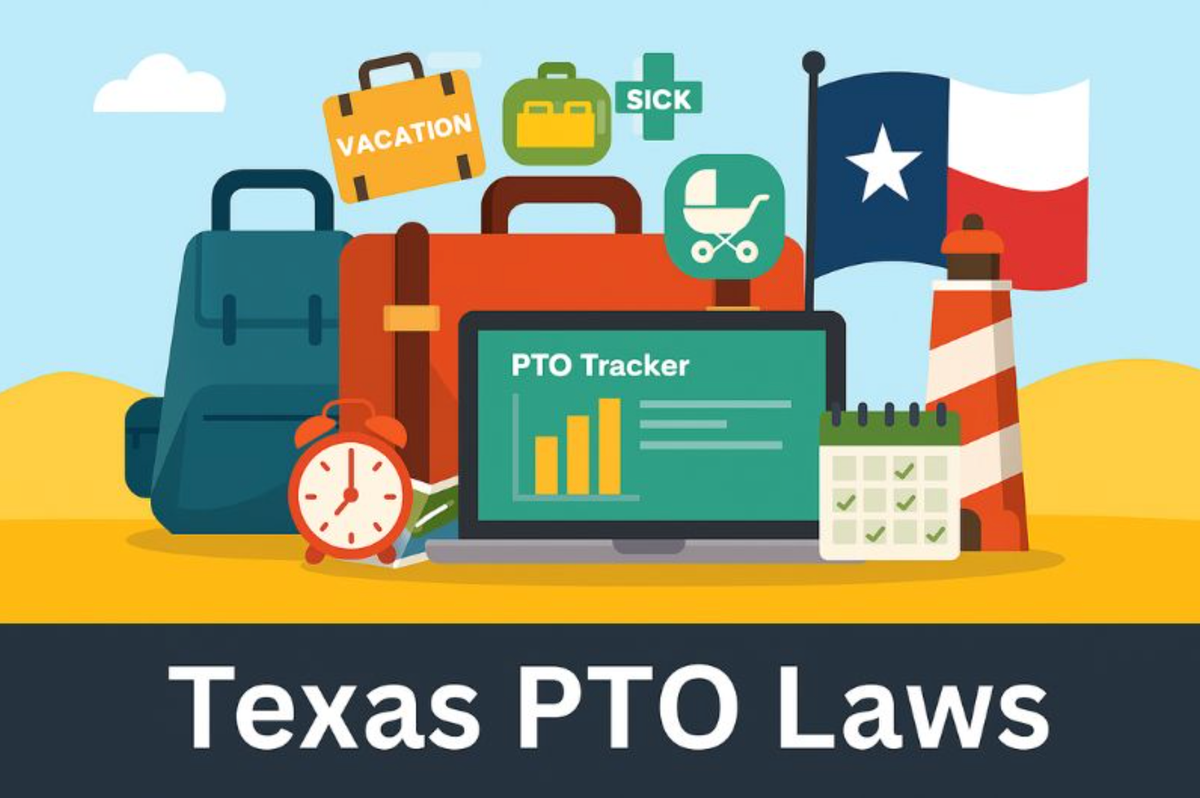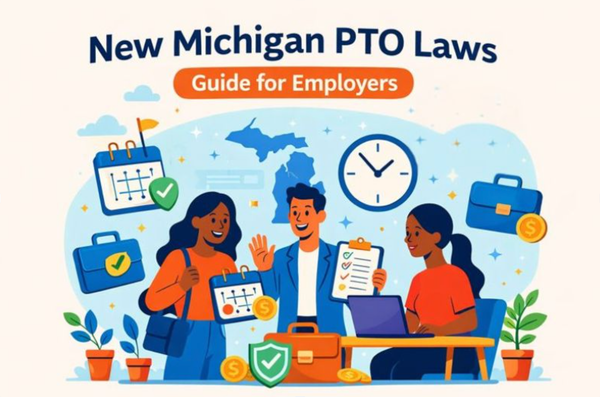Texas PTO laws in 2025: Your complete guide
This guide walks through how to structure a PTO policy that attracts talent, meets compliance standards, and reflects industry best practices in Texas.


Everything is bigger in Texas - or so the saying goes. As the Lone Star State continues to lead in business growth and job creation, the competitive hiring environment calls for more than just a monthly paycheck - workers want to share in the prosperity they’ve helped to create.
This requires Texas employers to be generous with benefits like paid vacation to attract and retain talented employees.
So what can your company offer to remain competitive, and how can you structure and manage the paid time off (PTO) benefit in a way that keeps your workers happy, plugged into your culture, and focused on results?
Federal and state mandates: PTO
As you explore Texas leave laws, it’s crucial to understand that there are no state-mandated laws requiring private employers to provide paid or unpaid leave, including paid vacation time and sick leave.
Texas employers typically create a written policy, often included in the employment agreement or company policy, detailing the accrual, usage, carryover, and termination of paid leave. Once an employer offers these benefits, they are required to adhere to their written policy, as stipulated by the Texas Payday Law.
Federal law, however, does require all Texas employers to adhere to the rules promulgated in the Family and Medical Leave Act (FMLA). This is applicable to employers with more than 50 staff members and are stationed within 75 miles of the employee, although there are still eligibility criteria that must be met by these employees. [1]
Additional reading: Texas Guidebook for employers - Vacation and sick leave accruals
PTO accrual in Texas: What’s common?
You may not be legally required to offer vacation leave, but it does make your company more attractive for prospective candidates. In Texas, around 87 percent of businesses offer a mixture of the following PTO benefits: [2]
- Paid vacation time.
- Maternity or paternity leave.
- Paid and unpaid sick leave.
- Payment of unused vacation time in the event of a work separation, such as a layoff.
- Jury duty leave.
- Paid and unpaid bereavement leave.
- Job-protected leave for personal medical reasons and family emergencies (such as those stipulated by the FMLA).
- Military leave, or military service.
- Paid holidays, such as Texas state holidays.
- Voting leave.
PTO accruals: The numbers
The number of PTO days available is determined by the size of the employer, the industry, and the talent the company would like to attract, but employers in Texas have full control over how accruals are set up. Here are common examples:
- Hourly accrual: 1 hour PTO for every 40 hours worked.
- Monthly accrual: 1 day PTO for every month worked.
- Lump sum allocation: 10-30 days front-loaded at the start of each year, to be used for all required leave.
- Tiered leave: Based on tenure, e.g., 10 days in year 1, 15 days in year 5, 20 days in year 10.
Consolidated leave packages (provide a single amount of leave for the employee to use as they choose) have risen in popularity in recent years, with 48 percent of Texas employers offering this form of leave benefit. [3] One reason for this is that it is easier for employers to track leave balances during each pay period.
When drafting your PTO policy, it can be helpful to simulate accruals based on work schedule or tenure. Use the BuddiesHR PTO accrual calculator to see what the real-life effects of PTO accruals are.

Texas PTO accrual extras: What else do you need to know
Knowing that you’re in total control over vacation benefits and how they accrue is empowering for businesses.
However, there are important details you need to know about before finalizing your policy - call it insider information. From use-it, or lose-it rules, to carryover limits, and what happens to accrued unused vacation days, you’ll be able to build a policy that really works.
🔄 Carryover limits
Texas does not restrict employers from allowing the carryover of unused paid leave or sick leave from one year to the next. If it makes financial sense or provides a better choice of candidates, then you are free to include this in your company policy. Popular benefits include:
- The allowance of a limited number of unused PTO days (e.g., 5 days per annum).
- Setting a cut-off date for the use of carryover days, such as within six months, or by the last day of December each year.
- Allowing a certain number of days to be converted to accrued leave payouts for qualified employees.
For fairness, transparency, and consistency to lead your carryover practices, they should be clearly outlined in your PTO policy.
🛑 PTO accrual caps
Many employers set caps on accrued leave, and the reasons for this are not just financial but also strategic, providing the following benefits:
- Control of financial liability associated with potential payout costs (if applicable).
- Encourages work-life balance and encourages employees to rest, avoiding burnout and increasing productivity.
- Streamlines accrual tracking, making it easier for payroll software and vacation trackers to manage leave requests, without endless custom rules.
Additional reading: Guidebook for employers - Texas PTO payout laws
⏳ Use-it, or lose-it provisions
Nothing in Texas state laws prohibits employers from drafting use-it, or lose-it provisions in their leave policies. Therefore, all employees should be informed of this provision in advance, and notifications should be sent with sufficient notice to encourage them to use their leave.
Texas-focused PTO accruals: Example of a hybrid policy
A clear PTO policy helps to attract talented individuals who are interested in working for companies that offer a rich portfolio of benefits.
Paid time off is a coveted benefit because it allows people the peace of mind that they can take leave without sacrificing their wages. The majority of Texan employees qualify for some PTO benefits, which look similar to the example below.
Businesses with under 50 employees are classified as SMEs in Texas and have unique PTO needs. Learn more in this post: Average PTO for small business: Are you competitive?
Texas PTO best practices
Since Texas law does not mandate paid time off, it is essential to build a clear, consistent, and enforceable policy. This policy will act as the foundation of your employment contract, which can be defended under the Texas Payday Law if there is a dispute. In summary, it means that you will be held liable for what you write down in your policies. Include all necessary information in the policy by following this template.
- Definitions: Clearly define PTO types available.
- Eligibility: Who qualifies for each type of leave and when they qualify (if tenure-based).
- Accrual schedule: Method and frequency of accrual updates.
- Usage rules: Leave requests, documentation required, notice to be given (e.g., two weeks' notice for paid vacation)
- Authorization and leave tracking: Who is responsible for authorizing leave requests, the turnaround time, and how leave balances will be tracked and communicated.
- Carryover rules: Limits, expiry rules, and payout (if applicable)
- Separation protocol: What vacation pay will the employee be entitled to, and what circumstances would qualify
- Convert/forfeit rules: When leave will be forfeited, or converted to cash or other leave options, such as sick leave.
- Policy changes: Stipulations that it is the company’s right to make changes when necessary.
- Policy integration: The acknowledgement that the policy informs contractual rights and obligations.
- Compliance: List which Texas laws and/or federal laws the policy complies with.
Most employers see the benefit of having a well-written document that guides both employees and company management. Vague rules are not a best practice, and for this reason, top employees usually steer clear of working for companies that haven’t been able to clearly communicate benefits.
Palmy vacation outshines everyone when it comes to tracking leave requests and approvals. Customize Palmy with your own PTO rules and let it keep track of the entire process for you.
⛔ Some tricky issues to watch for
Here at BuddiesHR, our experts, with their keen eye for detail, have identified a few key stipulations that need to be clarified in your PTO policy.
Federal Family and Medical Leave Act
Federal law does allow eligible employees to take up to 12 weeks of unpaid, job-protected leave per year for family and medical reasons, including maternity and paternity leave or a serious health condition.
Therefore, employees who wish to take parental leave and are prepared to do so without wages cannot be terminated from their employment. At the same time, this act requires employers to continue providing health insurance for employees during the leave period.
Reasonable accommodation
In the context of granting leave, reasonable accommodation refers to the employer’s obligation to make adjustments for employees who make a vacation request. This also includes workers who suffer from disabilities and may need medical attention as part of their treatment plan.
However, employers are not required to provide indefinite leave with no clear return date or approve leave that would cause undue financial or operational hardship.

Texas PTO laws in 2025
This comprehensive guide helps Texan employers build a competitive and legally sound PTO policy.
While there is no state law that requires employers to offer either paid or unpaid leave, federal laws may mandate this, as is the case with the Family and Medical Leave Act. Being regarded as a top employer for your employee benefits makes it easier to attract the top talent that the Lone Star State has to offer. The key takeaways from this guide are:
- No state-mandated PTO laws for Texas.
- Employers must adhere to the stipulations of their PTO policy, and if necessary, seek legal counsel to check the accuracy thereof.
- Employers have full control over leave accruals, carryovers, limits, and whether leave can be converted to cash.
- Around 87% of all Texan businesses offer some form of PTO benefit to remain competitive.
- Tools like BuddiesHR help to simplify the PTO process by automating leave tracking and balances.
Now is the time to put your PTO policy in writing and let BuddiesHR support your outstanding policy with an app made to help you run the entire process smoothly and with ease.
References:




